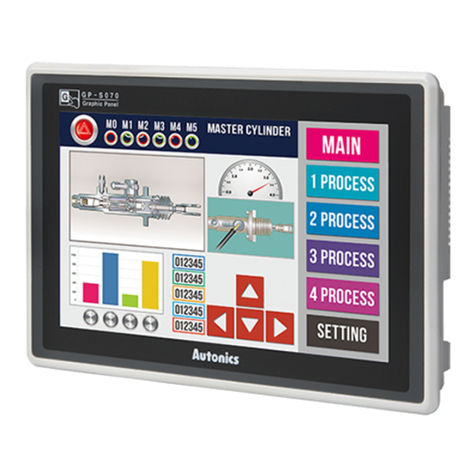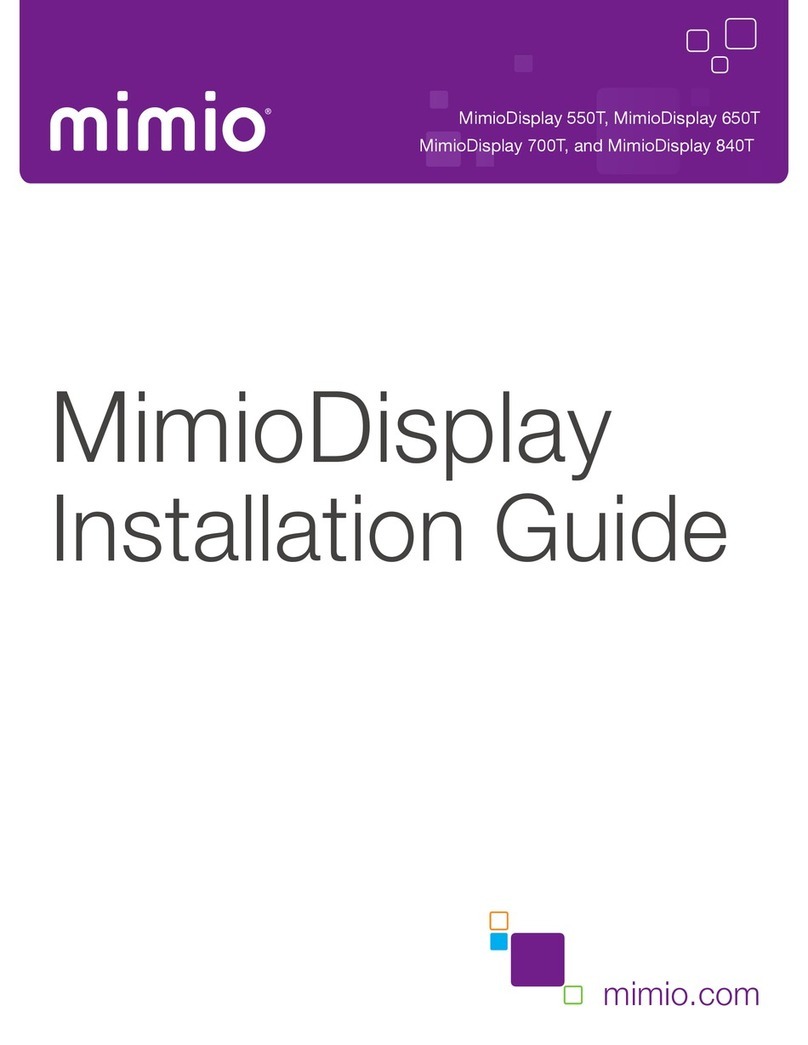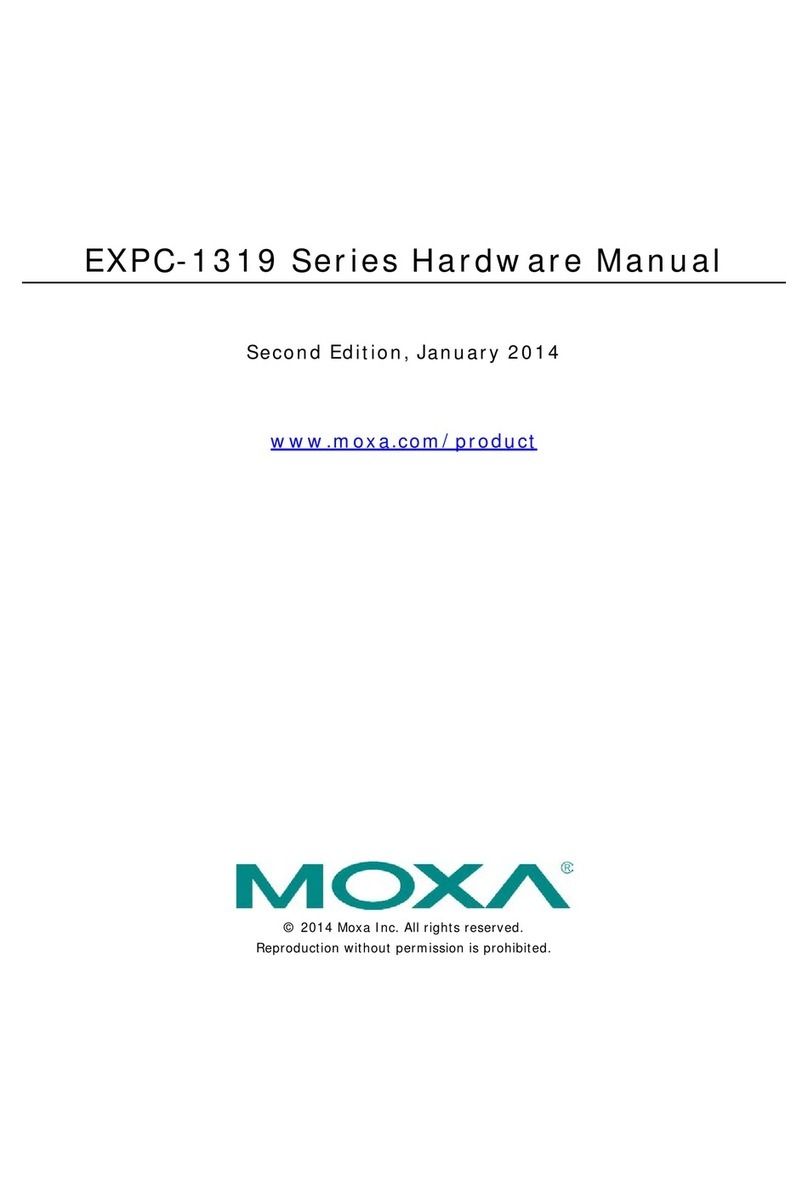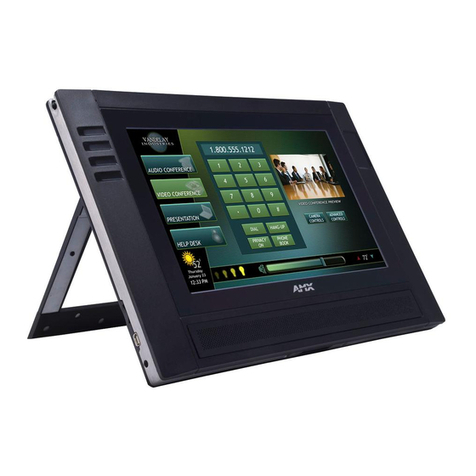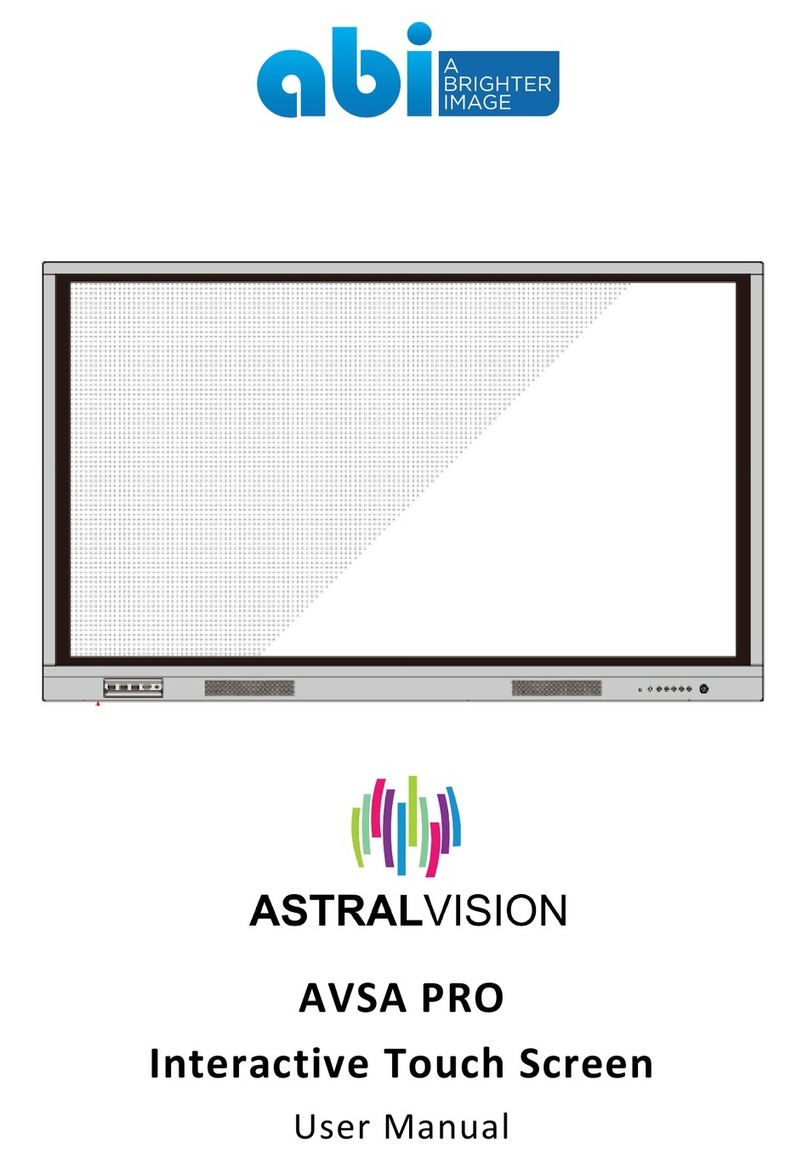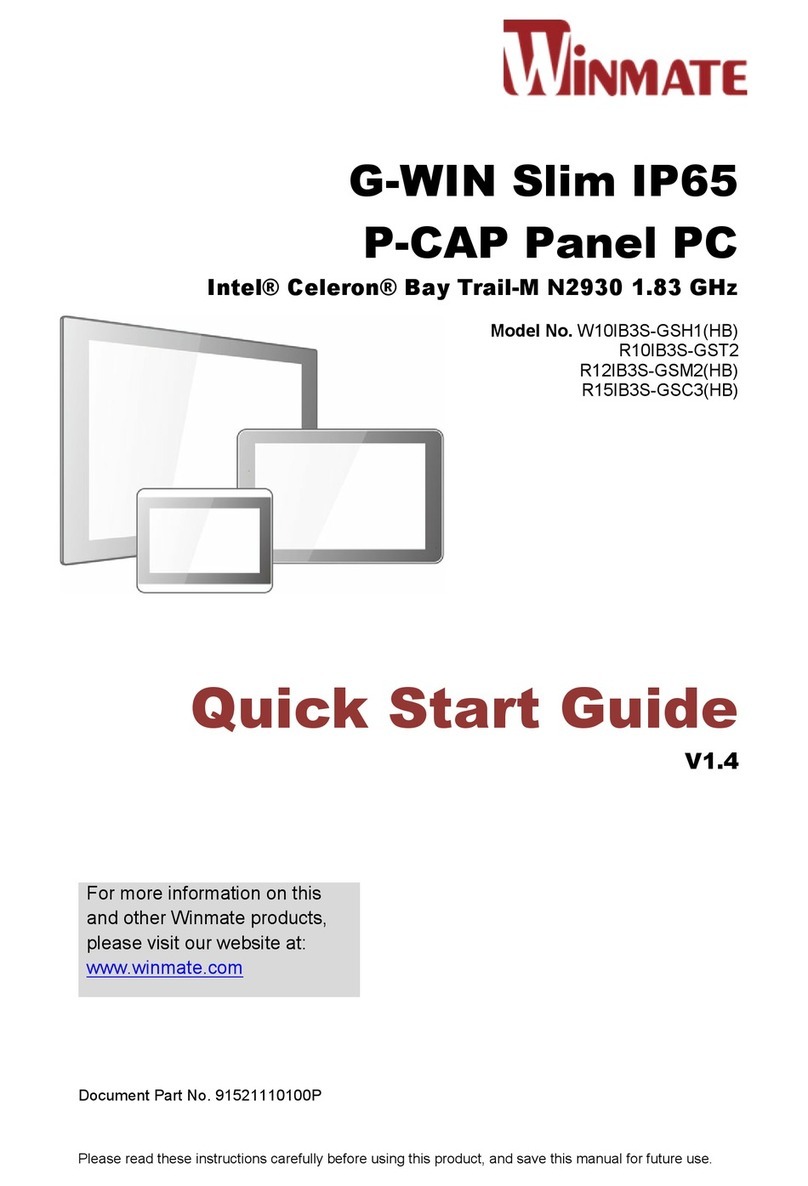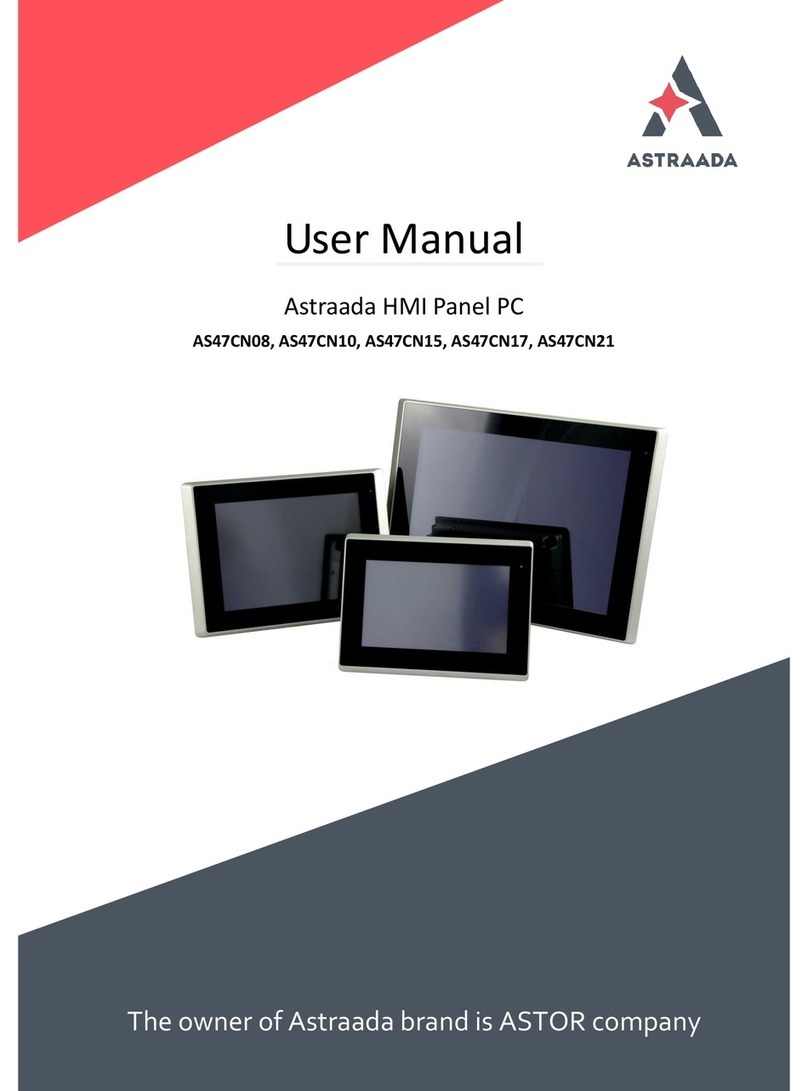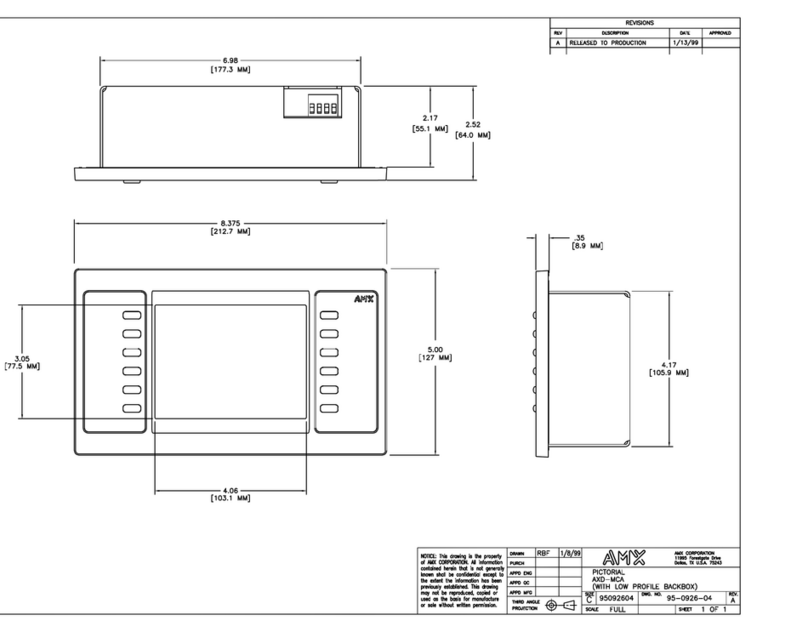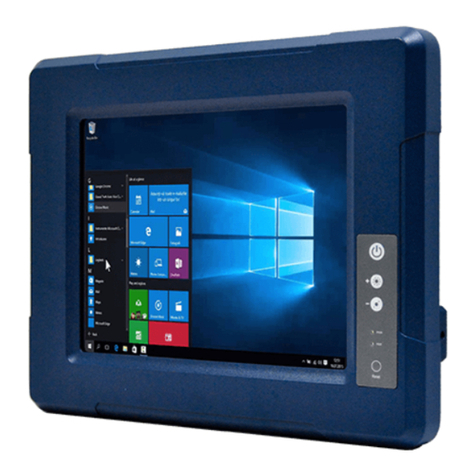STRATO PI User manual

"
Strato Pi Touch Display
User Guide
July 2016
Revision 002
a professional touch panel computer based on Raspberry Pi 3
"

Introduction 3
Features 4
Usage and connections 5
Hardware installation 5
µSD installation 5
Terminal block 6
Power supply 6
Dedicated GPIO pins 7
Software installation 7
Technical specifications 8
Dimensions 9
Disposal 10
Installation and use restrictions 10
Standards and regulations 10
Safety instructions 10
Set-up 10
Standards 11
1
User Guide

To avoid electrical shock or damage to the electronic components,
always disconnect the power from Strato Pi Touch Display before you
work on it. Don't touch any components on the Raspberry Pi card or
other cards while the device is on.
Follow all applicable electrical safety standards, guidelines,
specifications and regulations for installation, wiring and operations of
Strato Pi Touch Display.
Carefully and fully read this Strato Pi Touch Display user guide before
installation.
Strato Pi Touch Display is not authorised for use in safety-critical applications where a
failure of the product would reasonably be expected to cause personal injury or death.
Safety-critical applications include, without limitation, life support devices and systems,
equipment or systems for the operation of nuclear facilities and weapons systems. Strato
is neither designed nor intended for use in critical military or aerospace applications or
environments and for automotive applications or environment. Customer acknowledges
and agrees that any such use of Strato Pi Touch Display is solely at Customer's risk, and
that Customer is solely responsible for compliance with all legal and regulatory
requirements in connection with such use.
Sfera Labs S.r.l. may make changes to specifications and product descriptions at any time,
without notice. The product information on the web site or materials is subject to change
without notice.
Please download and read the Terms and Conditions document available at:
http://www.sferalabs.cc
Strato and Sfera Labs are trademarks of Sfera Labs S.r.l. Other brands and names may be
claimed as the property of others.
#
Copyright © 2016 Sfera Labs S.r.l. All rights reserved.
2
User Guide

Introduction
Strato Pi Touch Display is a touch panel computer based on Raspberry Pi Model B version
3, the original Raspberry Pi 7” Touch Display and the Strato Pi board (Mini, Base or UPS
version), assembled in a rugged, high-quality aluminium and steel chassis, that can be
installed in-wall with its optional back-box mount.
Strato Pi Touch Display is compliant with the 2014/35/UE (Low Voltage) and 2014/30/UE
(EMC) CE directives and harmonised standards for electromagnetic compatibility
(EN61000-6-2:2005), electrical safety (EN60664-1:2007), emission (EN61000-6-3:2007)
as well as the RoHS directive for hazardous substances (2011/65/UE).
3
User Guide

Features
Strato Pi Touch Display, common to all versions:
✓12-28Vdc power supply, with surge and reverse polarity protection
✓real time clock with on-board lithium back-up battery
✓on-board buzzer, connected to an I/O pin of the Raspberry Pi board, for acoustic
feedback
✓on-board power supply LED indicator
✓power supply on a screw terminal block
✓pre-assembled and tested Raspberry Pi 3 Model B with Strato Pi board (Mini, Base or
UPS version), original Raspberry Pi Touch Display and a high-quality aluminium and
steel chassis
✓side access to HDMI and 3.5mm jack for audio and composite video
✓access to all USB ports and Ethernet port (opposite to the power and serial terminal
block)
✓compliant with 2014/35/UE (Low Voltage), 2014/30/UE (EMC), EN61000-6-2:2005
(EMC Immunity), EN60664-1:2007 (Electrical safety), EN61000-6-3:2007 (Emission)
and 2011/65/UE (RoHS)
Strato Pi Base Touch Display:
✓standard RS-232 and RS-485 interfaces to the Raspberry Pi serial line, with opto-
isolator and electrostatic discharge protection
✓on-board LEDs for serial line activity
✓serial connections on a screw terminal block
✓hardware watchdog implemented in the Strato Pi board, fully independent from the
Raspberry Pi, controlled via the I/O pins of the Raspberry Pi board
Strato Pi UPS Touch Display:
✓all features of the Strato Pi Base Touch Display
✓integrated uninterruptible power supply, with external lead-acid 12V battery
✓simple UPS status and control via the I/O pins of the Raspberry Pi board
✓on-board LED for battery operations status.
4
User Guide

Usage and connections
Hardware installation
The Strato Pi Touch Display is shipped fully assembled. You will only have to access the
Raspberry Pi board to install your microSD card, and connect the power and other optional
cables.
Two M4 threaded holes in the back of the display panel are available to screw the display
directly to a panel board. A optional back box is also available for in-wall installations.
µSD installation
As the µSD socket is behind the flat cable that connects the Pi board with the display
control board, there is no direct access to the µSD socket when the Strato Pi UPS Touch
Display is assembled. You will need to remove the back steel cradle to expose the
electronic boards to insert and extract the µSD card.
1. Remove power and disconnect all other connections to the Strato Pi UPS Touch
Display
2. Lay the Strato Pi UPS Touch Display face down on a soft surface to avoid scratching
3. Unscrew the two lock nuts to free the back cradle from the aluminium display frame
4. Gently lift the cradle; pay attention not to damage the boards and connectors
5
User Guide

5. Locate the µSD card socket, on the Raspberry Pi board, directly behind the white flat
cable. The flat cable has a large ferrite toroid around it. It is not a problem if the toroid
slides up or down, but never remove the toroid
6. Gently move the cable to have enough room to insert the µSD card in its socket; the
card should be inserted with its contacts facing up (toward the back of the unit)
7. Once the card is installed, check that the flat cable is still firmly connected on both
sides; if not, gently lift the connector’s locks, replace the cable and push the locks back
in position
8. Ensure that the toroid is not directly in contact with the µSD card, to avoid damage to
the card when the cradle is re-installed
9. Gently place the cradle back, aligning the mounting screws on the sides; pay attention
not to damage the boards, connectors, and internal cables
10. Screw the two lock nuts.
Terminal block
The Strato Pi Mini Touch Display has a 2-way terminal block, used for the input voltage
connection.
The maximum conductor cross section is 2.08 mm2(14 AWG). Recommended stripping
length is 6 mm. Screw thread is M3. Never exceed 0.5 Nm torque when tightening the
screws. The label attached directly below the terminal block shows where to connect the
positive and negative terminals of the power supply cord.
The Strato Pi Base Touch Display and Strato Pi UPS Touch Display versions have a 9
positions terminal block, used for power, battery, and serial connections.
The maximum conductor cross section is 1.5 mm2(16 AWG), or 0.5 mm2when using
ferrules (highly recommended). Recommended stripping length is 5 mm. Screw thread is
M2. Never exceed 0.25 Nm torque when tightening the screws.
Refer to the appropriate Strato Pi board user guide for detailed connection instructions.
Power supply
Strato Pi Touch Display can be powered with DC voltage only:
✓DC: nominal voltage range 12V to 28.0V.
Respect the correct polarity shown in the schematic diagram (+ -). The power supply
circuit implements reverse polarity protection using an auto resetting fuse and surge
protection up to ±500V/2ohms 1.2/50μs.
A blue on-board LED is lit when power supply is available.
Never connect the Raspberry Pi micro-USB power plug.
6
User Guide

Dedicated GPIO pins
The Strato Pi board embedded in Strato Pi Touch Display uses some of the Raspberry Pi’s
GPIO pins which should not be used for other functions.
Software installation
Refer to the software installation section of the Strato Pi or Strato Pi Mini user guide for
detailed software installation and troubleshooting instructions.
The display and touch sensor unit used in Strato Pi Touch Display is the original 7” touch
display developed by the Raspberry Pi Foundation. Refer to the raspberrypi.org website
for additional software installation instructions.
Strato Pi Mini Board
GPIO pin
Direction
Description
GPIO17
out
set to high to sound the buzzer
Strato Pi Base and UPS Board
GPIO pin
Direction
Description
GPIO2/SDA
I2c SDA line for the real time clock
GPIO3/SCL
I2c SCL line for the real time clock
GPIO14/TXD
out
serial TX line
GPIO15/RXD
in
serial RX line
GPIO5
out
cycle high/low for watchdog heartbeat
GPIO6
out
set to high to enable the watchdog
GPIO12
in
high on watchdog timeout
GPIO16
out
set to high to enable the shutdown cycle
GPIO20
out
set to high to sound the buzzer
GPIO26
in
high when on battery power (UPS board only)
7
User Guide

Technical specifications
Power supply
12/28V⎓(VDC)
Reverse polarity protection with auto resetting fuse.
Surge protection up to ±500V/2ohms 1.2/50μs
5Vcc maximum output current (Ta 22 °C)
1.8 A @ 12V PS
2.0 A @ 24V PS
Battery input (UPS version only)
12V lead acid battery (not provided).
Suggested capacity:%1.2Ah. Reverse polarity
protection with auto resetting fuse. Surge protection
up to ±500V/2ohms 1.2/50μs
Battery charge voltage (UPS version only)
15V
Battery charge current (UPS version only)
30mA at 12V battery voltage
Voltage threshold for switching to battery mode
(UPS version only)
7.2V, 0.2V hysteresis
Typical current consumption at VS+=12V⎓
including Raspberry Pi 3 current, with low CPU/GPU
load and no USB devices connected
430mA w/o Ethernet and battery
450mA with Ethernet and battery
Actual current consumption may vary based on
working conditions
Typical current consumption at VS+=24V⎓
including Raspberry Pi 2 current, with low CPU/GPU
load and no USB devices connected
240mA w/o Ethernet and battery
250mA with Ethernet and battery
Actual current consumption may vary based on
working conditions
Raspberry platform compatibility
Pi 3 Model B
Raspberry Touch Display
display size: 7” diagonal
resolution: 800 x 400
touch panel: 10-finger multi-touch
Serial communication ports (Base and UPS versions
only)
RS485 Half-Duplex with automatic data direction
management
RS232 Full-Duplex
Baud Rates on COMM ports
1200 to 115200
ESD-Protection Voltage on RS232 TX/RX
±15kV human body model
±8kV contact discharge
ESD-Protection Voltage on RS485 A/B
±15kV human body model
±8kV contact discharge
Surge protection on RS485 A/B
Surge protection up to ±500V/2ohms 1.2/50μs;
600W peak pulse power capability at 10/1000μs
waveform
Fail safe feature on RS485
Yes
8
User Guide

Dimensions
9
User Guide

Disposal
(Waste Electrical & Electronic Equipment)
(Applicable in the European Union and other European countries with
separate collection systems). This marking on the product, accessories or
literature indicates that the product should not be disposed of with other
household waste at the end of their working life. To prevent possible harm
to the environment or human health from uncontrolled waste disposal, please separate
these items from other types of waste and recycle them responsibly to promote the
sustainable reuse of material resources. Household users should contact either the retailer
where they purchased this product, or their local government office, for details of where
and how they can take these items for environmentally safe recycling. This product and its
electronic accessories should not be mixed with other commercial wastes for disposal.
Strato Pi Touch Display contains a small non rechargeable manganese dioxide lithium coin
battery. This cell battery contain so little lithium that it should not qualify as a reactive
hazardous waste. If you need to follow specific disposal procedures for the battery, it can
be easily separated from the circuit board by simply cutting its two terminals near the
soldering points (paying attention not to pinch or fracture the battery body).
Installation and use restrictions
Standards and regulations
The design and the setting up of electrical systems must be performed according to the
relevant standards, guidelines, specifications and regulations of the relevant country. The
installation, configuration and programming of the devices must be carried out by trained
personnel.
The installation and wiring of connected devices must be performed according to the
recommendations of the manufacturers (reported on the specific data sheet of the product)
and according to the applicable standards.
All the relevant safety regulations, e.g. accident prevention regulations, law on technical
work equipment, must also be observed.
Safety instructions
Protect the unit against moisture, dirt and any kind of damage during transport, storage
and operation. Do not operate the unit outside the specified technical data.
Never open the housing. If not otherwise specified, install in closed housing (e.g.
distribution cabinet). Earth the unit at the terminals provided, if existing, for this purpose.
Do not obstruct cooling of the units. Keep out of the reach of children.
Set-up
For the first installation of the device proceed according to the following procedure:
✓make sure all power supplies and the external battery are disconnected
10
User Guide

✓install and wire the device according to the schematic diagrams on the specific data
sheet of the product
✓after completing the previous steps, switch on the power supply and other related
circuits.
Standards
This device complies with the essential requirements of the following directives and
harmonised standards:
✓2014/35/UE (Low Voltage)
✓2014/30/UE (EMC)
✓EN61000-6-2:2005 (EMC Immunity)
✓EN60664-1:2007 (Electrical safety)
✓EN61000-6-3:2007 (Emission)
✓2011/65/UE (RoHS).
11
User Guide
Table of contents
Popular Touch Panel manuals by other brands
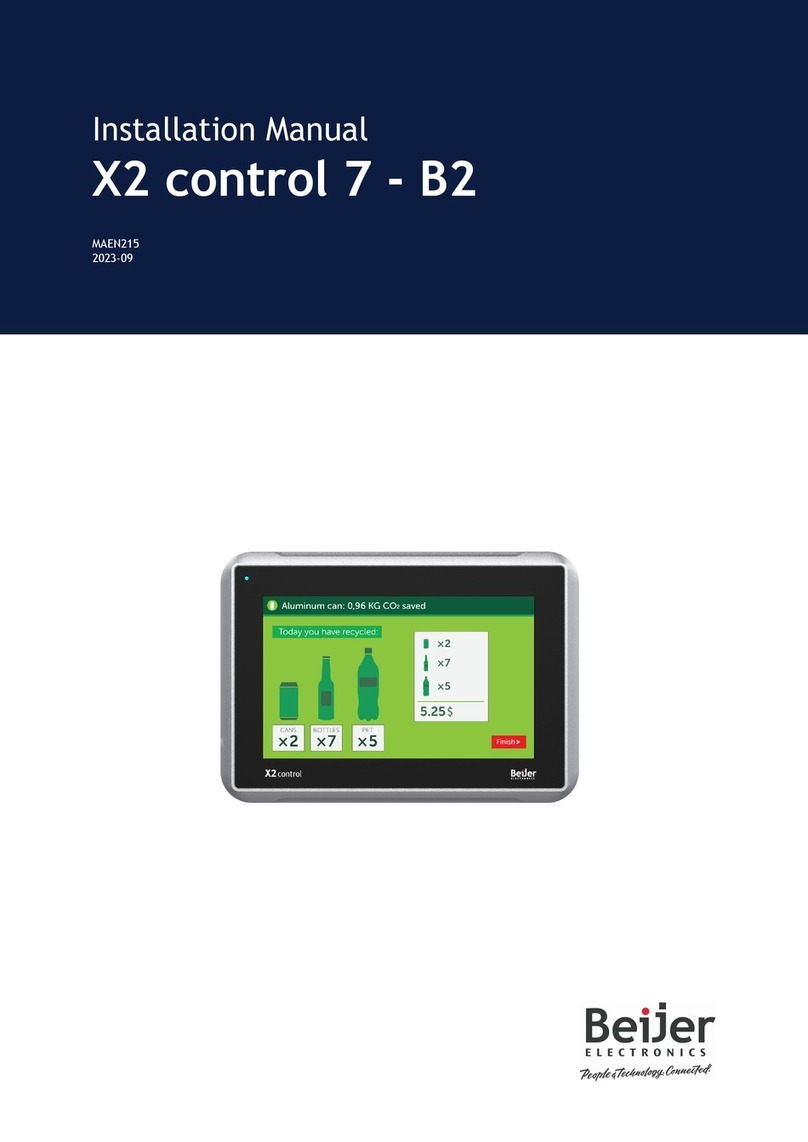
Beijer Electronics
Beijer Electronics X2 marine 7-B2 installation manual
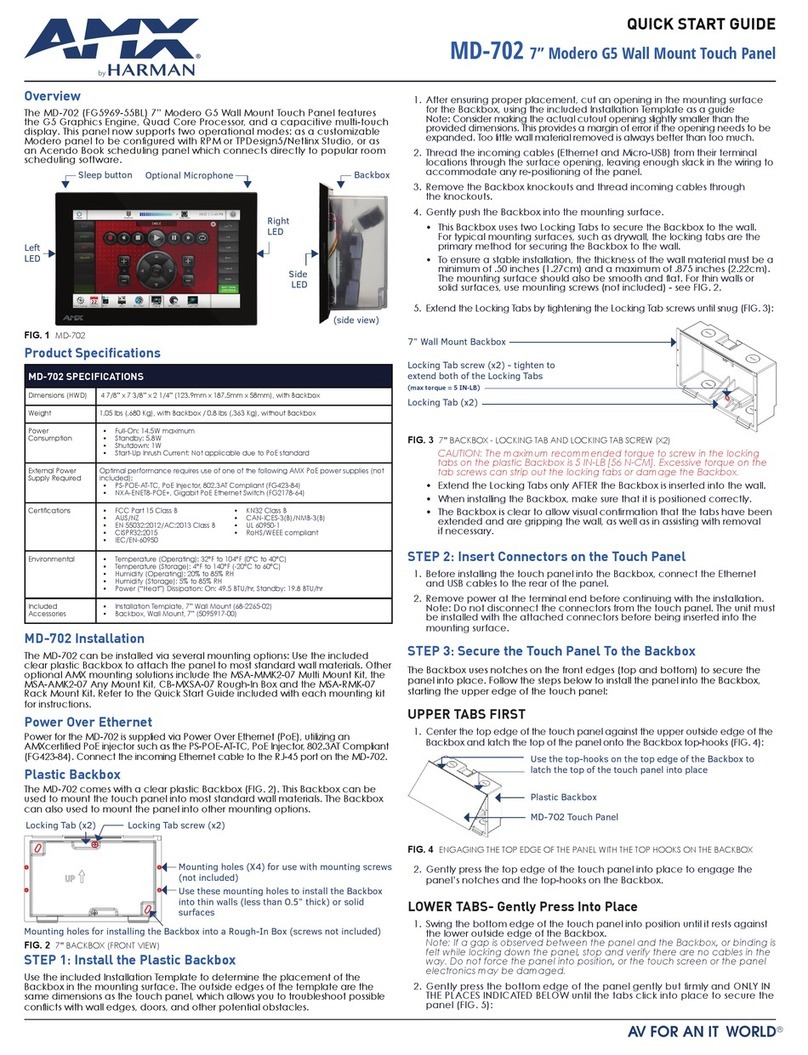
Harman
Harman FG5969-55BL quick start guide
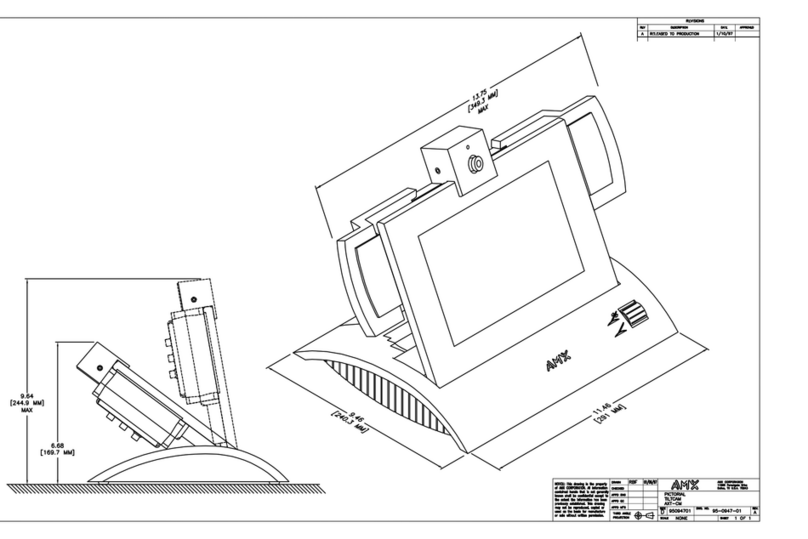
AMX
AMX AXT-CM Dimensional drawing

Kontron
Kontron MediClient 23.8" user guide
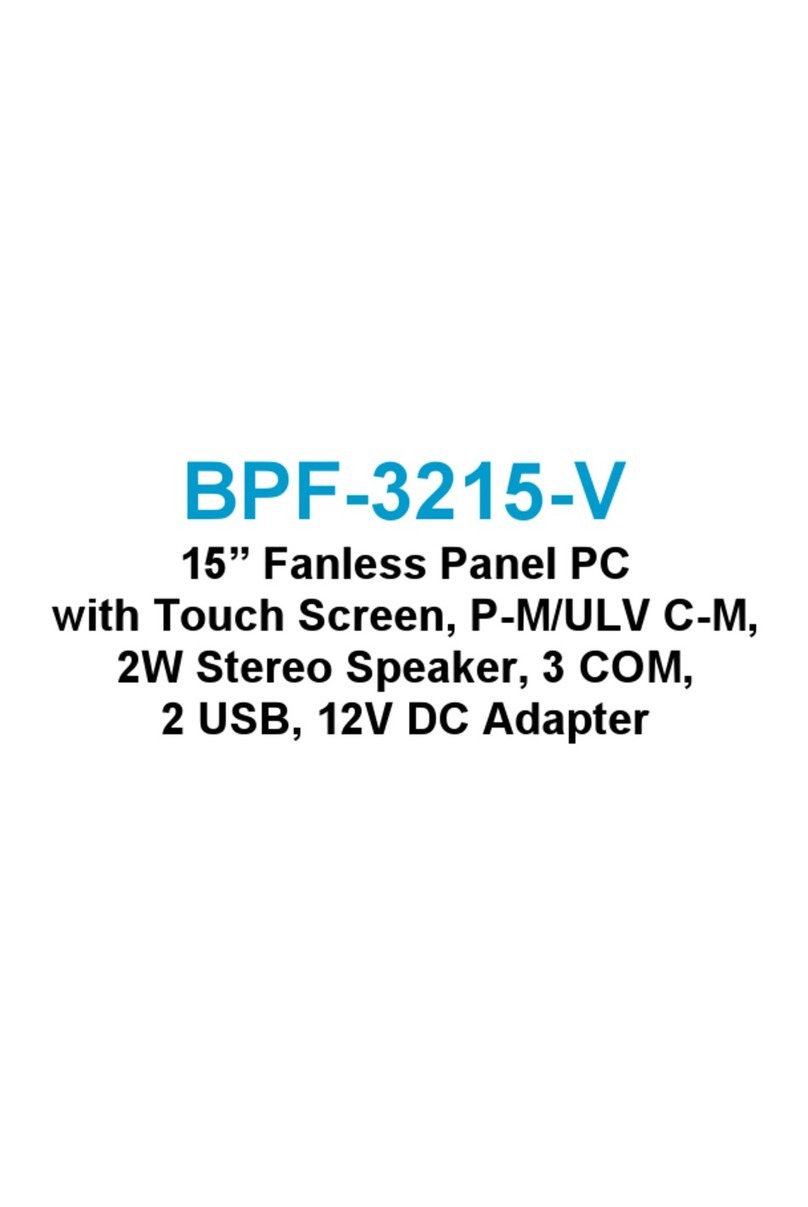
BOSER Technology
BOSER Technology BPF-3215-V user manual
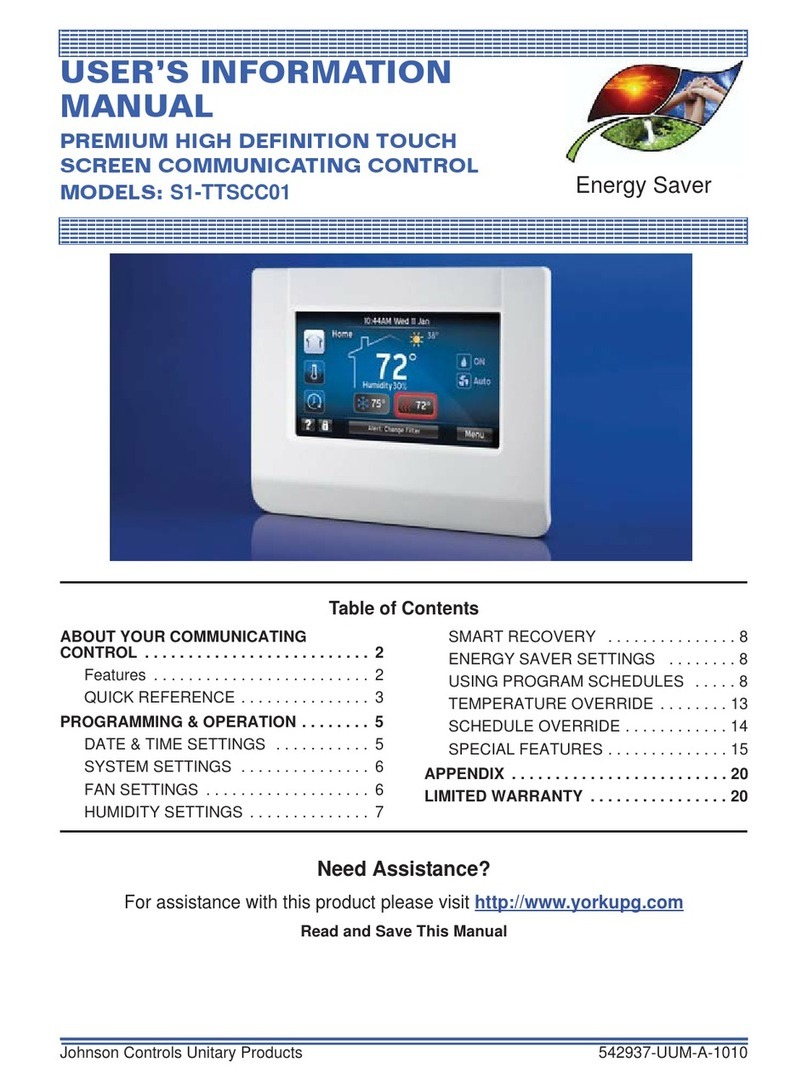
Johnson Controls
Johnson Controls S1-TTSCC01 User's information manual
